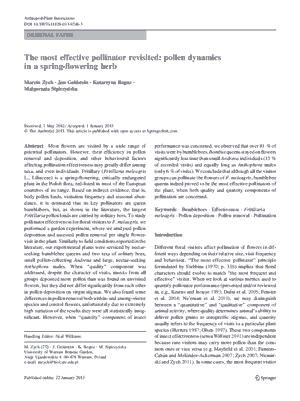NEWS 2013
The most effective pollinator revisited: pollen dynamics in a spring-flowering herb
Marcin ZYCH, Jan GOLDSTEIN, Katarzyna ROGUZ, Małgorzata STPICZYNSKA
Arthropod-Plant Interactions (2013)
doi: 10.1007/s11829-013-9246-3
University of Warsaw Botanic Garden, Aleje Ujazdowskie 4, 00-478 Warsaw, Poland
Abstract
Most flowers are visited by a wide range of potential pollinators. However, their efficiency in pollen removal and deposition, and other behavioural factors affecting pollination effectiveness may greatly differ among taxa, and even individuals. Fritillary (Fritillaria meleagris L., Liliaceae) is a spring flowering, critically endangered plant in the Polish flora, red-listed in most of the European countries of its range. Based on indirect evidence, that is, body pollen loads, visitation frequency and seasonal abundance, it is estimated that its key pollinators are queen bumblebees, but, as shown in the literature, the largest Fritillaria pollen loads are carried by solitary bees. To study pollinator effectiveness for floral visitors to F. meleagris, we performed a garden experiment, where we analysed pollen deposition and assessed pollen removal per single flower visit in the plant. Similarly to field conditions reported in the literature, our experimental plants were serviced by nectar seeking bumblebee queens and two taxa of solitary bees, small pollen-collecting Andrena and large, nectar-seeking Anthophora males. When ‘‘quality’’ component was addressed, despite the character of visits, insects from all groups deposited more pollen than was found on unvisited flowers, but they did not differ significantly from each other in pollen deposition on virgin stigmas. We also found some differences in pollen removal both within- and among-visitor species and control flowers, unfortunately due to extremely high variation of the results they were all statistically insignificant. However, when ‘‘quantity’’ component of insect performance was concerned, we observed that over 81 % of visits were by bumblebees. Bombus queens stayed on flowers significantly less time than small Andrena individuals (13 % of recorded visits) and equally long as Anthophora males (only 6 %of visits). We conclude that although all the visitor groups can pollinate the flowers of F. meleagris, bumblebee queens indeed proved to be the most effective pollinators of the plant, when both quality and quantity components of pollination are concerned.

